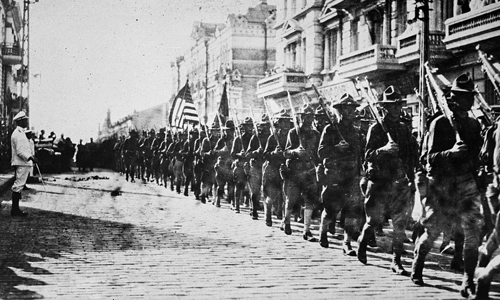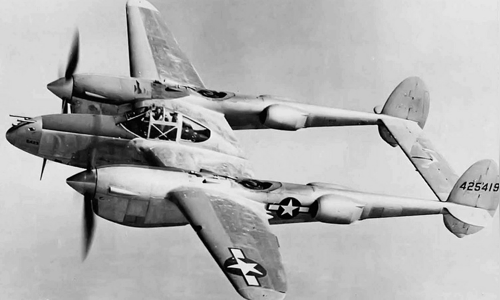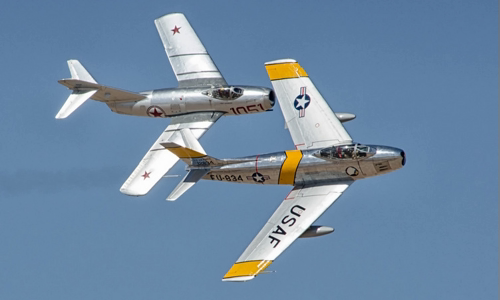The United States and the Soviet Union many times broke out fiercely on land and air, but fortunately did not lead to comprehensive war.
During the decades of the Cold War, the two leading superpowers of the world maintained a fierce confrontation, but never fought a total war. However, that did not mean that Soviet and American soldiers had never fought, but on the contrary, the two sides broke out several times, causing great losses of lives and weapons.

US forces entered the city of Vladivostok in August 1918 Photo: RBTH
In 1917, the Russian October Revolution was successful, the Bolshevik government was established. However, the Soviet Red Army faced fierce opposition from the White House movement of the Tsarist followers hoping to restore the Russian empire, leading to a civil war that broke out.
Fearing Russia's influence spread throughout Europe, the Treaty faction with four countries, mainly the United States, Britain, France and Japan, decided to support the White Army against Soviet Russia.
In August 1918, a British infantry regiment landed on Arkhangelsk in northern Russia to seize the city, turning it into a springboard to expand its military operations. A month later, the 339th Infantry Regiment and several other US units with a force of 5,000 were sent to Arkhangelsk to assist the British in a campaign called "Polar Bear Expedition".
The goal of the United States was to assemble 40,000 troops in the Czechoslovak army controlling the trans-Siberian strategic railway. Immediately, they encountered fierce resistance of the Red Army in Siberia.
The Red Army frequently raided the supply route, making it difficult for the Americans to maintain the front because Russia's vast delta terrain was far different from the trench war in Europe. When the harsh winter came, the Americans were increasingly pushed into defense, almost unable to connect with the Czechoslovak army.
Meanwhile, the Red Army continued its offensive in the early winter months on the Dvina River front, inflicting heavy blow on the US-British forces, forcing them to retreat to reorganize their forces.
In May 1919, Britain deployed 4,000 volunteer troops to rescue American troops in Arkhangelsk. American forces were evacuated with most of the Treaty troops in northern Russia, putting an end to military intervention. A report in October 1919 recorded US casualties with 210 casualties, of which 110 were killed in fighting, 30 missing, and 70 died from illness.
When World War II broke out, the United States and the Soviet Union were allies against the Nazi common enemy. However, that did not prevent the clash broke out between the forces of the two sides due to disastrous mistake.
On November 7, 1944, a group of US P-38 Lightning fighters attacked Soviet convoy near the city of Nis in Yugoslavia and led to a fierce air battle over the city.

American P-38 fighter during World War II Photo: USAF
At that time, the 6th Guards Infantry Corps was pursuing the Germans to the city of Belgrade. Suddenly, three US P-38 fighter squadrons with a total of 27 aircraft appeared, firing fiercely on the Soviet military convoy, killing 27 people on the spot, including the commander of the 6th Army.
Soviet air and air defense units were quickly deployed in response. Many Yak-3 fighters flew and flew just 20 meters above the ground, then attacked the American fighter formation at an altitude of 500 meters. The two sides fought fiercely because they both thought that the enemy was the Nazi army.
The air battle lasted 15 minutes and ended only when Soviet captain Alexander Koldunov risked his approach to the US-leading aircraft to signal.
In this battle, the Soviet Union lost four Yak fighters with 31 killed and 37 wounded. The US was shot down at least three P-38 fighters, two pilots were also killed. After extensive investigation, the two countries decided to keep the incident a secret to avoid German propaganda. Washington then repeatedly apologized to Moscow.
In the early 1950s, the Korean peninsula witnessed the first battles in the era of jet fighters between Soviet MiG-15s and US F-86s.
In October 1950, the Soviet Union deployed the 64th Fighter Army to North Korea as the country gradually fell under the attack of the Korean and UN coalition forces. Soviet MiG-15 fighters and hundreds of thousands of Chinese aspirations helped the Korean counter-attack and repel the enemy.
The Soviet Union possessed two pilots with the highest achievement in the war: Nikolai Sutyagin with 22 downed enemy aircraft and Yevgeny Pepelyaev with 19 victories. Meanwhile, the best American pilot was Joseph C. McConnell with 16 aircraft down the enemy.
Also during this war, the US Air Force bombed Soviet territory. On October 8, 1950, two US P-80 Shooting Star fighters attacked Sukhaya Rechka Airport in the Soviet Far East for mistaking it for a North Korea location.
The attack damaged six Soviet fighters and destroyed another one. All of these aircraft were P-63 Kingcobra models transferred to the Soviet Union by the United States during World War II. When the USSR appealed to the United Nations, US President Harry Truman admitted the mistake and said the attack was "a fault of direction and error in calculation".

MiG-15 (left) and F-86 fighters in an air show Photo: Matt Ottosen/Flickr
In the 1960s and 1970s, the US Central Intelligence Agency (CIA) and the Royal Iranian Air Force (IIAF) cooperated in a campaign codenamed "Project Dark Gene" to spy on the Soviet Union. This activity repeatedly encountered fierce response from Moscow.
On November 28, 1973, Iranian Air Force Major Mohamed Shokouhnia and US Air Force Colonel John Saunders piloted an RF-4C mechanical reconnaissance pretending to accidentally fly into Soviet airspace.
The Soviet system of police quickly discovered the aircraft violated airspace. Captain Gennady Eliseev, 35, deputy squadron of 982 Fighter Regiment, was ordered to launch from Vaziani air base in Georgia to intercept the RF-4C.
Eliseev's MiG-21SM fighter approached RF-4C reconnaissance when it was leaving Soviet airspace at speeds of up to 1,730 km / h. Captain Eliseev launched a K-13 thermo-range missile, but both shells slipped due to continuous maneuvering targets and dozens of thermal bait. The Soviet pilot then intended to fire the 23 mm cannon, but the cannon was stuck.
Determined not to let the enemy escape with the intelligence data gathered, Captain Eliseev accelerated, throwing his plane into the tail of the US reconnaissance plane while they were flying at supersonic speed.
The shocking impact caused the RF-4C to lose control and plummeted to the ground, while the MiG-21SM fighter aircraft shattered in the air. Eliseev just barely delivered the final message to the bridge "I defeated it!" before he died.
Saundes and Shokouhnia escaped their parachutes and were captured by Soviet border guards as soon as they landed. Eliseev was awarded the title of Hero of the Soviet Union, while the technical team in charge of weapons for the MiG-21SM was sentenced to many years in prison for failing to complete the mission.
The RF-4C flight crew was returned to Tehran by Moscow after two weeks in exchange for data on a Soviet satellite falling into Iranian territory earlier.



 DaliaAvila
DaliaAvila







